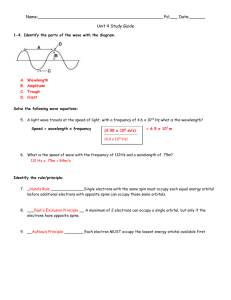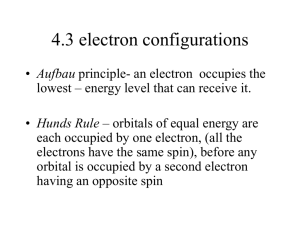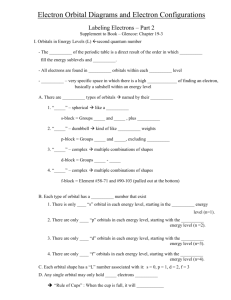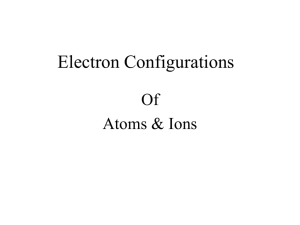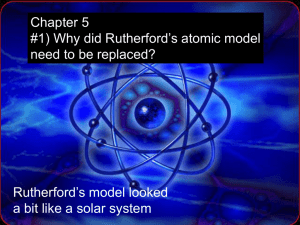Electron Configuration
advertisement
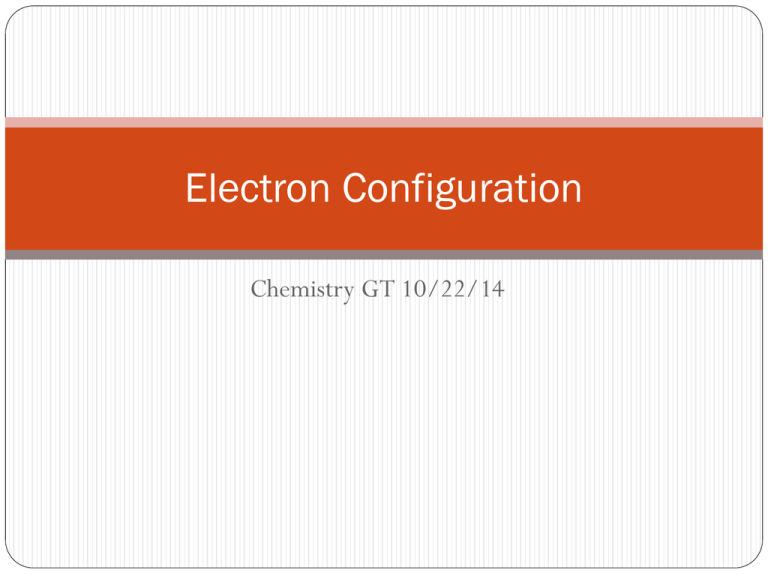
Electron Configuration Chemistry GT 10/22/14 Drill Get a packet from Ms. Bloedorn and number the pages 1-12 Write the address for these elements: Ag S Ce Write the full electron configuration for: O Mg Ga HW: pg. 4 in new packet – Electron Configuration Practice WS Objectives IWBAT: Identify the “block” (sublevel), “n” (principal energy level), and “position” (number of electrons) for any element. Create full electron configurations for any element. Create Noble Gas configurations for any element. Agenda Drill Practice electron configurations Electron Configurations Notes Closure Electron Configuration Practice pg. 3 –WS: Electron Configuration and Notations Do the configurations first Look at n=1 – count up the electrons (superscripts) with n=1 Look at n=2 – count up the electrons (superscripts) with n=2 And so on, for n=3, 4, 5 Electron Configuration! s, p, d, and f The different sections of the Periodic Table are very important in understanding Electron Configuration. There are 4 “Blocks” in the Periodic Table: the s-block, p-block, d-block, & f-block. Remember the special rules for the d- and fblocks: d – n-1 f – n - 2 What do s, p, d, and f mean? These refer to the sublevels within the principal quantum level (n). So, for n = 1, there is only one sublevel, s. n = 2, there are 2 sublevels: s & p n = 3, there are 3 sublevels: s, p, & d So, within each level, there are n sublevels. Block Table This shows the different blocks in the Periodic Table. It also shows in what order to write electron configurations (1s, 2s, 2p, 3s, 3p, 4s, 3d, 4p, 5s, 4d, 5p, 6s, 4f, 5d, 6p, 7s, 5f, 6d,7p) An Example As - Arsenic 1s2 2s2 2p6 3s2 3p6 4s2 3d10 4p3 The first number is which row it’s in, or the principal quantum number The character is the block it’s in, which refers to the sublevel The superscript is the total number of electrons in the sublevel The Noble Gas Configuration An obvious solution and convenient short cut! Noble Gas Configuration The Noble Gases are: He, Ne, Ar, Kr, Xe, Rn Notice that each noble gas finishes a row, or energy level. Noble gas configurations take advantage of this by condensing what you have to write: Ex. He : 1s2 Ex. C : 1s2 2s2 2p2 Noble Gas Configuration for C: [He] 2s2 2p2 Noble Gas Config. – an example The normal configuration for As-(Arsenic) 1s2 2s2 2p6 3s2 3p6 4s2 3d10 4p3 Notice, the part in yellow is the same as Argon’s configuration: 1s2 2s2 2p6 3s2 3p6 The noble gas configuration will start with the gas in the row before it. [Ar] 4s2 3d10 4p3 It cuts down on a lot of writing, and that’s a good thing. Orbital Diagrams They’re Useful! Orbitals Each sublevel (s, p, d, f) contains orbitals. Remember, orbitals are electron-clouds that hold the electrons 90% of the time. Each orbital can hold TWO electrons, so s - 2 electrons, 1 orbital p – 6 electrons, 3 orbitals d – 10 electrons, 5 orbitals f – 14 electrons, 7 orbitals The Aufbau Principle Each electron occupies the lowest energy orbital Electrons are Lazy!!! All orbitals related to an energy level are of equal energy. Ex. The three 2p orbitals are the same energy level. All equivalent energy Pauli Exclusion Principle A maximum of two electrons may occupy a single orbital, but only if the electrons have opposite spins. Spin -- Electrons has an associated “spin,” either one way or the other, like a top. These spins are called “spin up” and “spin down.” See example on board. Box = orbital Arrow = electron Hund’s Rule Single electrons with the same spin must occupy each equal-energy orbital before additional electrons with opposite spins can occupy the same orbitals. Ex. Nitrogen: •1s2 2s2 2p3 1s2 2s2 NOT Electrons are UNFRIENDLY Why? 2p3 1s2 2s2 2p3 The order of Things… Np1 Np2 Np3 Np4 Np5 Np6 Electrons, being unfriendly, fill up the empty orbitals before sharing orbitals. Similar to seats on a bus – on a bus, you sit alone, rather than with a stranger, if there is an option. Orbital s p d f Shape No. per sublevel Spherical 1 Figure-8, 3 dumbbells Double figure-8s 5 & donut with coffee Don’t worry! 7 The Shapes of the s, p, and d Orbitals Sketch these in the table F-Orbitals! Do not bother sketching these—just notice how STRANGE they are! If you want to see more, go to: http://www.orbitals.com/orb/orbtable.htm Visualizing Orbitals of Electrons z y The 3 axes represent 3-dimensional space x z y The nucleus of the atom is at the center of the three axes x The 1s orbital is a sphere, centered around the nucleus The 2s orbital is also a sphere The 2s electrons have a higher energy than the 1s electrons. Therefore, the 2s electrons are generally more distant from the nucleus, making the 2s orbital larger than the 1s orbital There are three 2p orbitals The three 2p orbitals are oriented perpendicular to each other z This is one 2p orbital (2py) y x z Another 2p orbital (2px) y x z The third 2p orbital (2pz) y x z 2px y x z 2px and 2pz y x z The three 2p orbitals, 2px, 2py, 2pz y x Once the 1s orbital is filled… The 2s orbital begins to fill Once the 2s orbital is filled… The 2p orbitals begin to fill Each 2p orbital intersects the 2s orbital and the 1s orbital Each 2p orbital gets one electron before pairing begins Once each 2p orbital is filled with a pair of electrons, then… The 3s orbital gets the next two electrons The 3s electrons have a higher energy than 1s, 2s, or 2p electrons 3s electrons are generally found further from the nucleus than 1s, 2s, or 2p electrons e- Config. and Orb. Diag. for Ions What is an ion? Examples of ions: Na+ Mg2+ Fe3+ Cl S2 I’ll do the configs. on the overhead. When writing electron configurations or orbital diagrams for ions it’s a little harder because it can look like a different atom. Just subtract the missing electrons or add the extra electrons Li+ (1s2 2s0) He (1s2) Orbital Diagrams, online! http://lectureonline.cl.msu.edu/~mmp/ period/electron.htm Closure Write the full electron configuration for B Al Ga What do they have in common?

